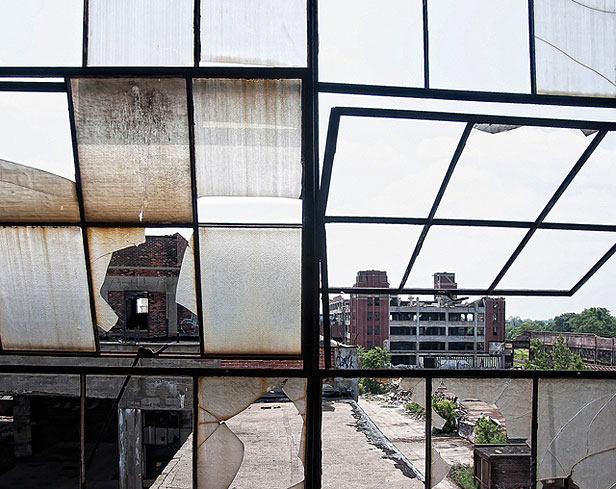The Feeding the City series is profiling several cities with thriving urban-agriculture and alt-food scenes.
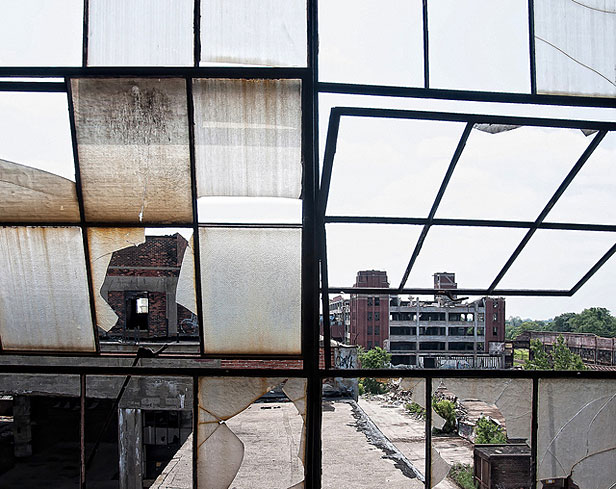 New views: Detroit is dotted with abandoned factories like this one, belonging to the Packard Motor Car Company.Photo courtesy of Ventri via Flickr
New views: Detroit is dotted with abandoned factories like this one, belonging to the Packard Motor Car Company.Photo courtesy of Ventri via Flickr
“We Shall Rise Again from the Ashes.
We Shall Hope for Better Things.”
— Mottoes on the Official Seal of Detroit (1826), quoted in Thomas Sugrue’s Origins of the Urban Crisis: Race and Inequality in Postwar Detroit
“Detroiters have an edge to us,” community organizer and urban-agriculture activist Malik Yakini told me. “We were forged in a furnace. You have to have a rough exterior to survive, to not be crushed.”
If he were talking about nearly any other U.S. city, Yakini’s language might sound overblown. In Detroit, it comes across as understatement.
Yakini was born at mid-century, at the peak of Detroit’s heyday as a manufacturing power, and he has watched the city’s long economic decline. Now, as chairman of the Detroit Black Food Security Network and a leader in several farm and garden projects around the city, he is at the center for a budding movement to revive it through food production.
Few cities outside of war zones have been subjected to such rapid, relentless economic decline. For the city’s legion of food activists, the vexations of the garden — marauding insects, galloping weeds, ravenous squirrels — must seem like child’s play. It’s impossible to understand Detroit’s urban-ag revival without understanding the forces that made it necessary.
Down and out in the Rust Belt
Like a weed shooting up through a crack on a well-trafficked sidewalk, Detroit’s urban-ag movement flourishes under difficult conditions. It marks the triumph of a resilient citizenry over a long series of brutal shocks stretching back 60 years.
Hailed by the media as the “Capital of the Twentieth Century,” 1940s-era Detroit was an industrial behemoth, churning out the vehicles in which a growing and prosperous middle class would glide down Eisenhower’s freshly laid highways. But those same cars and highways facilitated post-war America’s rapid suburbanization — and the economic evisceration of Detroit itself.
Getting a grip on the scale of Detroit’s economic catastrophe is difficult, like trying to estimate the size of an mastodon. You could start by looking at the fate of mass transit. By 1950, the nation’s most extensive network of streetcars connected the dense neighborhoods of the metropolis to its bustling factories. Confident in the automobile as the urban transportation vehicle of the future, Detroit’s leaders dismantled the streetcars in 1956.
Ironically, the city’s manufacturing engine had already begun to sputter. As the car industry consolidated and shifted toward automation, its factories needed more room to spread out. It found that room in the suburbs. As the historian Thomas Sugrue writes in his 1998 book, Origins of the Urban Crisis: Race and Inequality in Postwar Detroit, “Between 1947 and 1958, the Big Three built 25 new plants in the Detroit metropolitan area, all of them in suburban communities, most more than 15 miles from the center city.” And the car industry headed for the ‘burbs, inner-city employment plunged. Between 1947 and 1963, Sugrue reports, Detroit surrendered more than a third of its manufacturing jobs. Later, the car industry would begin fleeing Michigan altogether, seeking bargain-priced labor in the union-hostile South.
A steadily accelerating torrent of residents followed jobs to the suburbs. In 1950, Detroit’s population peaked at 1.8 million. Within a decade, the city had shed 10 percent of its residents, or more than 100,000 residents. Meanwhile, the suburban frontier swelled; the population of Detroit’s suburbs grew by 25 percent over the same period.
The long process of Detroit’s hollowing out — and the expansion of its suburban ring — had begun. Today, Detroit’s population stands at 900,000 — half of its 1950 level. Meanwhile, the greater metropolitan area houses 4.8 million people — an 85 percent jump from 1950.
“If you’re here in the city, you cannot hide from poverty and suffering. It’s right there in your face. You can either embrace humanity and try to live every moment to try to make everyone’s life easier, or you leave … if you have the option to.” — Ashley Atkinson, Greening of Detroit
Detroit’s economic collapse also had an ugly racial dimension. As Sugrue makes clear, the hundreds of thousands of African-Americans who streamed into Detroit from the South in the 1930s and ‘40s confronted savage racism along with economic opportunity. By the ‘50s, economic opportunity had begun to crumble, but discrimination persisted. Racist real estate practices largely kept blacks in the inner city, Sugrue shows.
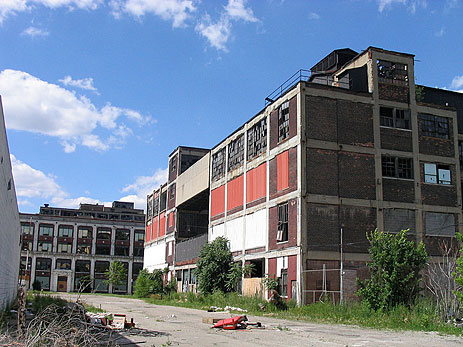 Carless whispers: More abandoned motor factories.Photo courtesy of Sean Marshall via FlickrWhile all Rust Belt cities experienced “white flight” after World War II, in Detroit, the phenomenon reached its zenith. Yakini remembers encountering hostility when his family moved into a largely white neighborhood around 1960. Within a few years, he told me, it had transformed into a black neighborhood. Today, more than 80 percent of Detroit’s population is African-American; whites make up just 12 percent of the population. Jobs remain scarce; the city’s unemployment rate stands at 15.5 percent — more than 50 percent higher than the national average. Crime filled the vacuum as jobs vanished. The onetime “Capital of the 20th Century” now reigns as the U.S. “murder capital.”
Carless whispers: More abandoned motor factories.Photo courtesy of Sean Marshall via FlickrWhile all Rust Belt cities experienced “white flight” after World War II, in Detroit, the phenomenon reached its zenith. Yakini remembers encountering hostility when his family moved into a largely white neighborhood around 1960. Within a few years, he told me, it had transformed into a black neighborhood. Today, more than 80 percent of Detroit’s population is African-American; whites make up just 12 percent of the population. Jobs remain scarce; the city’s unemployment rate stands at 15.5 percent — more than 50 percent higher than the national average. Crime filled the vacuum as jobs vanished. The onetime “Capital of the 20th Century” now reigns as the U.S. “murder capital.”
Unbuilding boom
As Detroit’s manufacturing base shrunk and population halved in the decades after 1950, its tax receipts plummeted. That meant, as Yakini pointed out to me, a long, slow decline in the quality of public services — everything from mass transit to road and park maintenance and garbage collection and fire fighting.
“We have half the population, but we still have to to maintain the whole footprint” of the city, Yakini points out.
The city’s population exodus left hundreds of thousands of residences empty. The roar of bulldozers knocking down homes has been a familiar sound for decades. In an extraordinary 2006 essay in Lost Magazine called “Disappeared Detroit,” Jeff Byles teases out the ramifications of life in a city with more homes than people. “Unbuilding,” a local architect told Byles, “has surpassed building as the city’s major archi
tectural activity.” The citizenry, fed up with the hazards of living near rotting structures, has gotten caught up in recurring demolition frenzies over the decades.
Between 1970 and 2000, Byles reports, “more than 161,000 dwellings were demolished in Detroit, amounting to almost one-third of the city’s occupied housing stock — that’s more than the total number of occupied dwellings today in the entire city of Cincinnati.” And demolition activity continues today. “Mayor Readies Detroit Demolition Plan,” declares a March headline. As Byles makes clear, every Detroit mayor since the ‘70s placates the public by boasting of the next big demolition spree.
All of the resulting vacant land, much of which ends up owned by the city, provides the very asset that fuels the garden movement.
Fertile ground for a revival
Given the past half-century, it’s no wonder that Yakini and his fellow Detroit citizens “have an edge” to them. Yet Detroit’s postwar furnace has also forged a remarkable resiliency and creativity in its citizens. You can hear it in the Motown Sound of the ‘60s — and see it in the urban-agriculture movement of today. Detroit residents have a “fortitude and resilience that produces creativity,” Yakini told me. “People trying to survive in a hard environment tend to become very creative.”
Ashley Atkinson, 31, director of urban agriculture and project development for Greening of Detroit, a nonprofit founded in 1989, echoes that idea, adding that the relentless tension of living in a city under economic siege can bring people together. “You can be the most wealthy, privileged person in the world,” she told me. “But if you’re here in the city, you cannot hide from poverty and suffering. It’s right there in your face. You can either embrace humanity and try to live every moment to try to make everyone’s life easier, or you leave … if you have the option to.”
It’s that civic-minded impulse to “make everyone’s life easier” that drives the garden movement. I talked to several agriculture activists for this essay, and they all characterized the urban-ag revival as a community-based, almost painfully cooperative effort, anchored by a few key local nonprofit institutions. Greening of Detroit may be the most pervasive of them — it provides a broad array of support, including tools and compost, to the city’s nearly 1,200 registered vegetable gardens. These gardens range from single-family plots to community and school gardens to 37 market gardens, which are business enterprises that sell their goods at farmers’ markets.
According to Atkinson, gardens of all types continue sprouting up at a steady rate throughout the city. What kind of potential do they have to bring healthy food to the city as well as jobs? Atkinson pointed me to a study released in June by the C.S. Mott Group at Michigan State University gauging “The Production Potential of Detroit’s Vacant Land.”
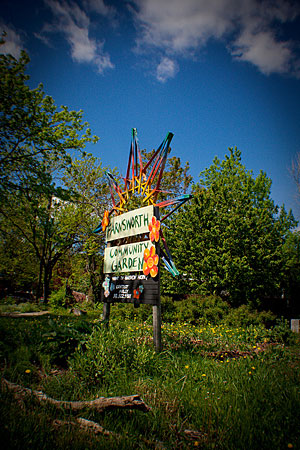 Lots o’ land: Located on the corner of Farnsworth and Moran, this community garden was started by Molly Motor long before urban farming became the buzzword of the day in Detroit. Photo courtesy of Angela Anderson-Cobb via FlickrThe city’s food-production capacity is, in a word, immense. The Mott researchers reckon that there are 44,000 vacant publicly owned land parcels, representing nearly 5,000 acres, around the city. That’s more than enough land for the city’s farmers and gardeners to crank out a significant portion of Detroit’s fruit and vegetable needs, the study showed. They calculate that with proper investments in season-extension infrastructure like hoop houses (which wouldn’t require fossil fuel for heating even in Detroit’s frigid winters) and space to store crops like potatoes, skilled farmers using biointensive techniques on just 570 acres could produce 70 percent of the vegetables consumed in Detroit and 40 percent of the fruit. (Non-professional-level gardeners could produce that much food with 2,100 acres under cultivation.)
Lots o’ land: Located on the corner of Farnsworth and Moran, this community garden was started by Molly Motor long before urban farming became the buzzword of the day in Detroit. Photo courtesy of Angela Anderson-Cobb via FlickrThe city’s food-production capacity is, in a word, immense. The Mott researchers reckon that there are 44,000 vacant publicly owned land parcels, representing nearly 5,000 acres, around the city. That’s more than enough land for the city’s farmers and gardeners to crank out a significant portion of Detroit’s fruit and vegetable needs, the study showed. They calculate that with proper investments in season-extension infrastructure like hoop houses (which wouldn’t require fossil fuel for heating even in Detroit’s frigid winters) and space to store crops like potatoes, skilled farmers using biointensive techniques on just 570 acres could produce 70 percent of the vegetables consumed in Detroit and 40 percent of the fruit. (Non-professional-level gardeners could produce that much food with 2,100 acres under cultivation.)
The Mott study doesn’t comment on the possible economic benefits, but back-of-the envelope calculations suggests that they are significant. Detroit residents spend less than the residents of any other American city on food — about $2,200 combined at home and in restaurants and bars in 2009, according to the data crunchers at the financial website Bundle. If fruit and vegetables make up about 7.5 percent each of that $871 spent on food consumed at home, going by USDA estimates, and if Detroit growers were to provide 70 percent of the vegetables consumed by the city’s 900,000 residents, that would amount to $41.2 million in annual sales. For fruits, receipts would be $23 million. Grand total: $63 million per year into the local economy.
Seeding the next phase of growth
One can imagine that infusion rippling through the economy in myriad ways. In her book The Economy of Cities, Jane Jacobs argues that in vibrant urban economies, new industries are always arising from existing one. Once that process stops — as it did in the case of Detroit’s car factories — economic stagnation sets in. Urban agriculture, dispersed throughout the city at the scale envisioned by the Mott study, could provide a Jacobsian engine for sustainable growth.
New distribution networks, for example, would need to arise to move that produce from farmers to retail outlets, providing opportunity for entrepreneurship. Then there’s retail, which in itself represents a massive opportunity, both to capture profits from local produce and to improve public health. In 2007, A&P closed its last two Detroit-area supermarkets. It had been the last national supermarket chain operating in the city. Now, more than half of Detroit residents live in areas that have severely limited access to healthy food, a study from Yale’s Rudd Center recently found, making them “statistically more likely to suffer or die prematurely from a diet-related disease, holding other key factors constant,” the report concluded.
Yet high-quality food retail could be economically viable activity. “A 2003 University of Michigan study concluded that the city could support 41 supermarkets with at least 40,000 square feet of space based on its population and spending habits,” the Detroit Free-Press reports. Today there are none. If a bounty of city-grown vegetables began to overwhelm existing farmers markets, local citizens might be moved to band together, raise investment cash, and create full-service food retail outlets that feature local produce. Such projects would keep food dollars circulating within the community, broaden access to healthy food, and provide robust market access to local farmers.
Detroit’s heritage as a manufacturing powerhouse could come into play as well. Yakini told me that people are already talking about launching businesses to fabricate the kind of hardware necessary for inten
sive urban agriculture: hoop houses for season extension, hand tools, etc. Working closely with innovative farmers at the frontier of intensive urban agriculture, such businesses could generate urban-farming tools sought out the world over.
To hear Atkinson tell it, the city is well on its way to becoming a powerhouse of community-based urban agriculture: dotted with smallholder farms, along with myriad family and community gardens, churning out top-quality produce, feeding the city’s citizens as well as its economy.
The obstacles mainly have to do with policy, she says. “Right now, farming is essentially illegal in the city,” she told me. Farming can’t be the principle use of city land, legally. That means you can have a market garden on the land around your home — the principle use of your land; but you can’t buy an empty parcel explicitly to farm it. “Those rules have to change for market gardening to take off here,” she told me.
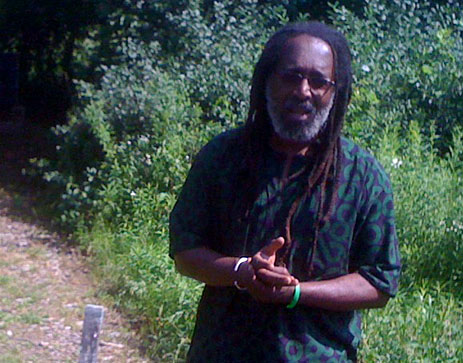 Green powerhouse: Malik Yakini, chairman of the Detroit Black Food Security NetworkPhoto: Tom PhilpottHappily, policy change is afoot, even if the pace is slow.
Green powerhouse: Malik Yakini, chairman of the Detroit Black Food Security NetworkPhoto: Tom PhilpottHappily, policy change is afoot, even if the pace is slow.
Late in 2009, the Detroit Food Policy Council, which advises the City Council, started meeting. Yakini chairs it — Atkinson told me it grew out of efforts by the Black Food Security Network — and Atkinson also sits on it. One of its tasks is to amend and propose policies to facilitate urban agriculture. Then there’s the Urban Agriculture Work Group, which operates under the City Planning Commission, and which has also been working on tweaking city policy to make it friendly to for-profit farming.
Atkinson is confident that these efforts will change city policy. She and fellow members of the Policy Council and Work Group “wouldn’t be working so hard, doing homework and attending theses meetings, if we didn’t believe it would happen … eventually.”
Yakini agrees that urban agriculture has “tremendous economic potential” in Detroit, but doesn’t want to overplay it. He stresses the need for investments in infrastructure along with policy change. Moreover, he sees Detroit not in isolation, but rather as part of a regional food economy, joined in a network with urban centers and rural areas in Michigan as well as Illinois and Ohio.
Yakini also sees vast value beyond the economics of Detroit’s urban agriculture scene. “Even if the gardening movement had no economic viability, just the fact that it’s bringing people together for the common good is very significant,” he said. “African-Americans in Detroit tend to have a sense of despair and helplessness that is a direct result of oppression. Producing even some of our own food restores a sense of power, a sense that we can shape our own destiny.”
In the next week, I’ll profile three of the projects that are greening Detroit’s fate.

